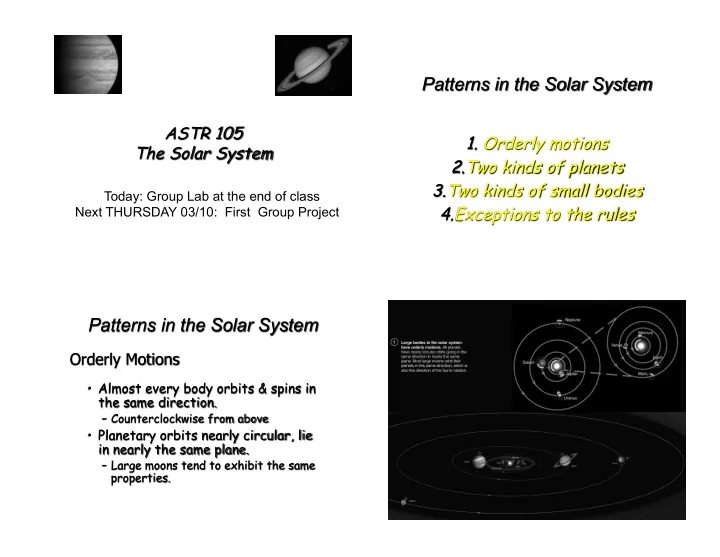

Patterns in the Solar System ASTR 105 1. Orderly motions The Solar System 2. Two kinds of planets 3. Two kinds of small bodies Today: Group Lab at the end of class 4. Exceptions to the rules Next THURSDAY 03/10: First Group Project Patterns in the Solar System Orderly Motions • Almost every body orbits & spins in the same direction. – Counterclockwise from above • Planetary orbits nearly circular, lie in nearly the same plane. – Large moons tend to exhibit the same properties. 4
Patterns in the Solar System The Planets at a Glance Two Types of Planets Terrestrial Planets Jovian Planets • Smaller size and mass • Larger size and mass • Mostly rock and metal • Mostly H, He, and H- Small compounds Giant Inner • High density • Low density • Solid surface • No solid surface Outer Rocky Dwarf • Few or no moons, no • Rings and many moons Gas Planets rings Planets Planets • Closer to the Sun, • Farther from the Sun, -Misfits closer together farther apart Patterns in the Solar System Patterns in the Solar System Two Types of Small Bodies Exceptions to the rules • Rotations • Rocky – Venus • Backwards – Asteroids – Uranus • Ice and rock • On its side • Orbits – Comets – Triton • Backwards • Kuiper belt objects • Moons • Oort cloud comets – Earth’s Moon • Big (compared to Earth) – Most small moons • Screwy shapes & orbits
Next: Where did the elements in the Formation of the Solar System solar nebula come from? Right after the Big Bang • Mostly Hydrogen (75%) • Some Helium (25%) • Virtually nothing else
Today Galactic Recycling • Almost • H & He entirely – created in the Big Hydrogen Bang (70%) • Heavier elements – made in stars and then recycled through • Some Helium interstellar space (28%) • Tiny amount of everything else (2%) Clicker Question Clicker Question What would the “Astronomer’s Periodic What would the “Astronomer’s Periodic Table” look like if we looked at the Table” look like if we looked at the universe in 13 billion years? universe in 13 billion years? A. It would look exactly the same A. It would look exactly the same B. The H would be a little smaller but not much, B. The H would be a little smaller but not much, other elements a little bigger other elements a little bigger C. The H and He would be pretty much gone, all C. The H and He would be pretty much gone, all converted to heavier elements converted to heavier elements D. All the elements would be the same size (I.e. D. All the elements would be the same size (I.e. the same amount of everything) the same amount of everything)
13 Billion Years From Today NEBULAR FORMATION Theory • Still mostly for the Solar System Hydrogen (65%) • A bit more Helium (31%) How does a solar system form from a cloud of gas? • A little more of everything else (4%) Collapse of the Solar Nebula ! Four Challenges for a Solar System Formation Theory 1. Orderly motions 2. Two kinds of planets 3. Two kinds of small bodies • As the solar nebula collapses it: – Spins faster 4. Exceptions to the rules – Heats up – Flattens out into a disk
Collapse of the Solar Nebula Conservation of Angular Momentum M x V x R = Constant Why does it spin faster? Clicker Question Clicker Question If angular momentum (m × v × r) is conserved If angular momentum (m × v × r) is conserved (stays constant) what happens if r goes (stays constant) what happens if r goes down (no change in m)? down (no change in m)? A. v stays the same A. v stays the same B. v goes down B. v goes down C. v goes up C. v goes up
Conservation of Angular Momentum Spinning Demos M x V x R = Constant https://www.youtube.com/watch?v=UZlW1a63KZs Collapse of the Solar Nebula Why does it heat up? Gravitational Energy ⇒ Kinetic Energy Kinetic Energy = Thermal Energy
Incorrect Reasons Collapse of the Solar Nebula Gravity is “pulling the material into a disk” – Gravity is pulling everything in (spherically, not into a flat disk) OR The disk is being “flung out into a disk” Why does it flatten into a – Individual gas particles are in simple disk? orbits (orbits don’t get flung out) Flattening of the Solar Nebula • As the nebula collapses, clumps of gas collide & merge. • Their random velocities average out into the nebula’s direction of rotation. Extreme Conformism! • The spinning nebula assumes the shape of a disk. Go with the flow or crash to oblivion
a) The orbital period of the Moon is 29.5 days, and its LAB distance from Earth is 238,900 miles. What is the mass Solar Nebula: of the Earth? • SPINNING – Conservation of angular momentum b) The New Horizon spacecraft will take 9 years to travel to • HOT Pluto (D=7.5x10 9 km). What is its average speed? – Collapse ⇒ compression • DISK c) Uranus’s orbit lasts 84 years. If you live at its South pole, – Collisions force common motions for roughly how long would you see continuous day light? d) A new planet is discovered, orbiting a star of mass M=2x10 30 kg in 5.7 years. At what distance from the star is the planet orbiting? e) List at least 3 differences between Pluto and the other solar planets. What feature did astronomers agree upon as a way to differentiate a ‘planet’ from a ‘dwarf planet’? 33
Recommend
More recommend